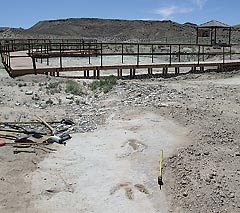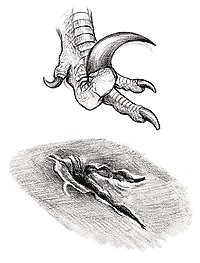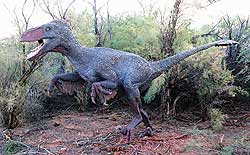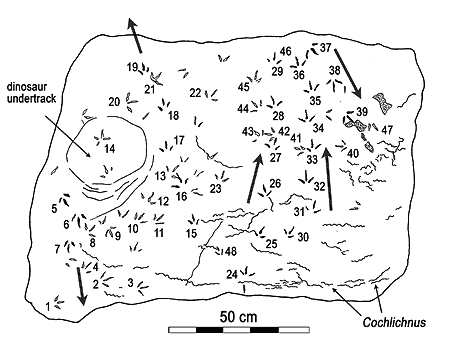PALEO HAPPENINGS August 2020 |
|||||||||
| What Happened to Cretaceous Park? by Martin Lockley, Moab Giants | |||||||||
Millions of kids and as many adults know Jurassic Park. But the Cretaceous was longer than the Jurassic. While dazzled by Jurassic dinosaurs like Stegosaurus (the Colorado State fossil), Allosaurus (the Utah state fossil) and Brachiosaurus (first found near Grand Junction) there are also famous Cretaceous dinosaurs like T. rex, Triceratops, Velociraptor and Utahraptor. Moab can rejoice that this latter oversized 20-foot-long raptor was found nearby in the Cedar Mountain Formation, one of the world’s richest Cretaceous graveyards. In strata covering a 30 million year time slice ,representing fertile river, lake and pond settings we find at least 25 unique dinosaur species, including freshwater sharks, amphibians (frogs), turtles, crocodilian, pterosaurs, at least a dozen mammals, and a beautiful set of bird tracks. The place was teaming with life, and surely qualifies for worldwide recognition as an “Early Cretaceous Park”
As local residents may know, House Bill 322 proposes creating Utahraptor State Park a $10 million development along highway 191, close to where Utahraptor was found near Dalton Wells. This site was once a historic Civilian Conservation Corps barracks, that later became a Japanese American internment camp during World War II. Here layers of 20th century history, overlay 120,000 centuries of prehistory. (Do the math)! Dr. Jim Kirkland, Utah State Paleontologist and cheerleader for this beloved, world-class menagerie of Dalton Wells dinosaurs, noted that: “full-cast skeletons from the site are exhibited in more than 30 museums around the world.” Why are these not on display in Moab? Let us hope that it is just a matter of not-too-geological time. Kirkland has influential supporters like Mike Mower, Governor Gary Herbert’s deputy chief of staff, who stated that “making this a state park …is… something incredible, not only now, but for years to come” … millions of years “in the making. How cool is it that? Utah, of all 50 states, has the coolest dinosaur?” No dispute here, and Moab has the recently named Moabosaurus, unique to Grand County.
|
|||||||||


 Moab’s dinosaur skeletons remain a well-kept secret, because after excavation they are taken to museums elsewhere (e.g., Salt Lake City). Put another way, once removed from a dinosaur quarry there is little left to see. But tracks, the main subject of this series, mostly remain in place. The Mill Canyon Dinosaur Tracksite (MTDT) is one of the most visually spectacular in the region, with the first known North American example of two toed raptor tracks: the claw on the inner toe of raptors was retracted like a cat’s and so did not leave a third toe trace. At the BLM-managed MTDT site just south west of the airport, one can also see 3-toed tracks of large and medium-sized theropods, ornithopods and sauropods. The informative interpretative signs help tell the story of Moab’s Cretaceous Park: the tracks are the actual ancient landscape.
Moab’s dinosaur skeletons remain a well-kept secret, because after excavation they are taken to museums elsewhere (e.g., Salt Lake City). Put another way, once removed from a dinosaur quarry there is little left to see. But tracks, the main subject of this series, mostly remain in place. The Mill Canyon Dinosaur Tracksite (MTDT) is one of the most visually spectacular in the region, with the first known North American example of two toed raptor tracks: the claw on the inner toe of raptors was retracted like a cat’s and so did not leave a third toe trace. At the BLM-managed MTDT site just south west of the airport, one can also see 3-toed tracks of large and medium-sized theropods, ornithopods and sauropods. The informative interpretative signs help tell the story of Moab’s Cretaceous Park: the tracks are the actual ancient landscape. 